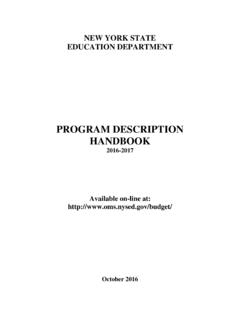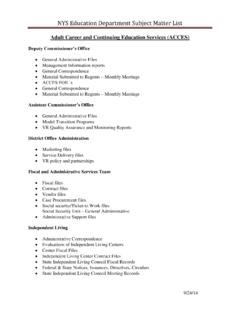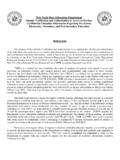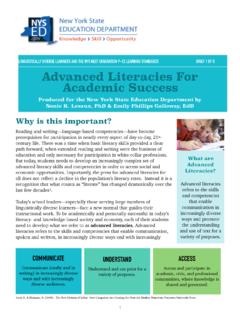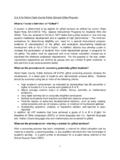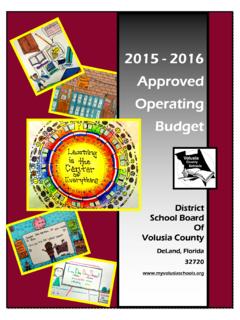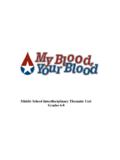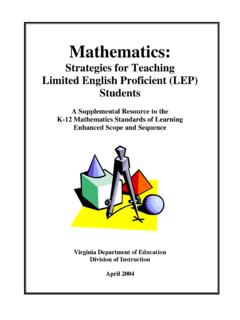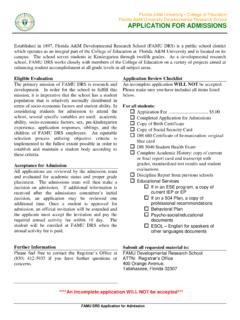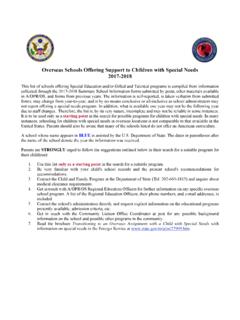Transcription of Co-Teaching and Collaboration for Teachers of …
1 Co-Teaching and Collaboration for Teachers of ELLs: The Role of Administrators Agenda & Objectives a Common Understanding of Co-Teaching of a Successful Co-Teaching Model of the Administrator Models of Co-Teaching Paradigm of Co-Teaching & Supporting Teachers 2 Long Island RBE-RN - July 2015 Co-Teaching What is your definition of Co-Teaching ? What do you see as your role in Co-Teaching ? What does Co-Teaching look like? What does Co-Teaching not look like? Co-Teaching Quick Write Long Island RBE-RN - July 2015 3 Developing a Common Understanding: General Definition of Co-Teaching Two Teachers collaborate to deliver instruction. Originated in Special Education to address least restrictive environment Many definitions of Co-Teaching exist depending on: the purpose of the Collaboration ; and the context of the instruction.
2 There is limited information and data available on successful Co-Teaching models for English Language Learners. Honigsfeld, A., & Dove, M. (2008). Co-Teaching in the ESL classroom. Delta Kappa Gamma Bulletin,74(2), 8-14. Retrieved from Long Island RBE-RN - July 2015 4 Developing a Common Understanding: Co-Teaching in an ENL Program In ENL programs Co-Teaching can be characterized as a unique Collaboration between a general education or content teacher and the English as a New Language teacher to: co-plan, co-deliver, and individualize instruction for all students in a class; work together creatively to accommodate the language proficiencies, cultural diversity and educational backgrounds of the students in the class; overcome instructional challenges constructively.
3 Long Island RBE-RN - July 2015 5 So, What Should Co- Teachers Do? Long Island RBE-RN - July 2015 6 Developing a Common Understanding: Co-Teaching for ELLs is One teacher planning and delivering all instruction Just an extra set of hands ( , the glorified teacher s aide) in the room An ESL teacher only working with ELLs while the general education teacher only works with non-ELLs An ESL teacher working with a small group of ELLs apart from general class The same as a Special Education inclusion class utilizing paraprofessionals Long Island RBE-RN - July 2015 7 Components of a Successful Co-Teaching Model Planning & Administration Implementation Successful Co-Teaching District & School level support Classroom level support Long Island RBE-RN - July 2015 8 Components of a Successful Co-Teaching Model Planning & Administration Full administrative support and Collaboration at the district and building levels Professional Development provided to all Teachers and administrators in the model Voluntary
4 Partnerships supported by administration Establishment of common expectations Shared accountability for outcomes Martinsen Holt, N. (2004). Pull-out to Collaboration : Becoming an effective ESL co- teacher (Unpublished master's thesis). Hamline University, Saint Paul, MN. Retrieved from: Long Island RBE-RN - July 2015 9 Components of a Successful Co-Teaching Model - Implementation Sacred shared planning time Shared delivery of instruction Mutual responsibility and ownership of class Style of Co-Teaching is dynamic, adapting as necessary based on content delivered and student needs Martinsen Holt, N. (2004). Pull-out to Collaboration : Becoming an effective ESL co- teacher (Unpublished master's thesis). Hamline University, Saint Paul, MN. Retrieved from: Long Island RBE-RN - July 2015 10 Role of the Administrator of a Co-Teaching Model Careful selection of partner Teachers Frequent communication and Collaboration with building principals Providing appropriate training for all Teachers involved in the model Facilitating planning and scheduling Providing adequate resources to ensure successful implementation Hendrickson, D.
5 (2011). ESL and mainstream Co-Teaching practices in one elementary school (Unpublished master's thesis). Hamline University, St. Paul, MN. Retrieved from: Long Island RBE-RN - July 2015 11 Administrative Challenges Identifying the specific needs of each school Developing a common understanding with building principals of the goals and expectations of the model Offering appropriate support for Teachers willing to take on Co-Teaching challenges Establishing a sense of priority for ELL programs and successful implementation of the Co-Teaching model Encouraging teacher leadership roles Dove, M., & Honigsfeld, A. (2010). ESL coteaching and Collaboration : Opportunities to develop teacher leadership and enhance student learning. TESOL Journal, 1(1), 3-22.
6 Long Island RBE-RN - July 2015 These points can be especially challenging when the administrator for ELL programs carries multiple roles/titles and is not continually present in the building. 12 Common Models of Co-Teaching Whole Class Instruction Team teaching One Lead teacher , One teacher Assesses One Lead teacher , One teaching on Purpose Small Group Instruction Station teaching (akin to Centers in Elementary classrooms) Alternative teaching Parallel teaching Re- teaching Martinsen Holt, N. (2004). Pull-out to Collaboration : Becoming an effective ESL co- teacher (Unpublished master's thesis). Hamline University, Saint Paul, MN. Retrieved from: Honigsfeld, A., & Dove, M. (2008). Co-Teaching in the ESL classroom. Delta Kappa Gamma Bulletin,74(2), 8-14.
7 Retrieved from Long Island RBE-RN - July 2015 13 Common Models of Co-Teaching : Team teaching One heterogeneous group of students Both Teachers instruct all students together Teachers often tag-team content-area instruction Requires high levels of planning and mutual trust Long Island RBE-RN - July 2015 14 Common Models of Co-Teaching : One Lead teacher , One Assesses (or observes) ,%20 One%20 Observe%202 One heterogeneous group of students One teacher takes the lead delivering instruction Second teacher circulates the room, recording formative assessment data ( , checklists, anecdotal records, etc.) Second teacher may also take notes on which activities were successful for particular students or caused confusion. Teachers may switch roles during the lesson.
8 Long Island RBE-RN - July 2015 15 Common Models of Co-Teaching : One Lead teacher , One teaching on Purpose One heterogeneous group of students Lead teacher delivers whole class instruction Second teacher purposefully provides individualized instruction, mini-lessons or conferences for individuals or small groups Teachers switch roles throughout the lesson Long Island RBE-RN - July 2015 16 Common Models of Co-Teaching : Station teaching (akin to Centers ) Two or more groups of students Teachers divide the class into smaller groups Each teacher delivers a portion of the content to small groups Groups rotate and may work on small group assignments or independently between sessions with each teacher Long Island RBE-RN - July 2015 17 Common Models of Co-Teaching : Alternative teaching Two groups of students One teacher leads whole group instruction Second teacher works with a small group on a pre-identified focus area Can help build background knowledge May be disruptive or noisy Long Island RBE-RN - July 2015 18 Common Models of Co-Teaching .
9 Parallel teaching Two (or more) heterogeneous equal groups of students Each teacher instructs one group covering the same content Provides additional opportunities for student interaction and monitoring of student learning = Long Island RBE-RN - July 2015 19 Common Models of Co-Teaching : Re-Teach teaching Two semi-equal groups of students grouped according to their needs One teacher reinforces concepts, previously learned skills to students not ready to move on Second teacher teaches alternative material or enrichment to those who are ready to move on Group assignment is flexible and temporary Long Island RBE-RN - July 2015 20 Most Effective (but least commonly observed) Model of Co-Teaching Team teaching teacher A & B co-lead instruction teacher A & B are seen as equals by all students in the class teacher A& B share the responsibility and have time to plan and develop appropriate materials, supports and scaffolds for ELLs, struggling learners and higher achieving students In this model, the Teachers are equals and students benefit by having two instructional professionals in the classroom.
10 Long Island RBE-RN - July 2015 21 Least Effective (but most commonly observed) Model of Co-Teaching One Lead teacher , One Assisting teacher ( One Teach, One Drift) teacher A always leads the instruction teacher B circulates and assists students or focuses on assisting a specific group of students In this model, the Teachers are not seen as equals and minimizes the advantage of having two instructional professionals in the classroom. Long Island RBE-RN - July 2015 22 Confidence-Competence Paradigm of Co-Teaching Adapted from Understanding Technology Confidence Survival Mastery Innovation We re still figuring out our collaborative teaching styles. We re not sure what to do but we re trying our best. Capability We ve received training and experimented with a few different Co-Teaching models for instruction.
